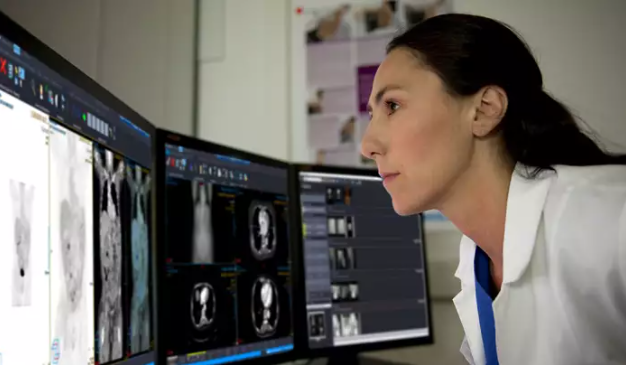
Here is a list of some of the top overarching trends in enterprise radiology systems the editors of Imaging Technology News (ITN) have observed over the past year at the 2020 Radiology Society of North America (RSNA) and the 2021 Healthcare Information Management Systems Society (HIMSS) conferences.
1. Introduction of Newly Engineered Cloud-based Platforms
Enterprise imaging vendors are releasing completely new, revamped platforms that are programmed from the ground up as web-based platforms, rather than older architecture systems that were modified to be used as cloud-based systems. Several new systems were launched by major vendors that use the latest programming architecture to optimize their systems for the latest advances in cloud computing and to better leverage software as a service (SaaS) business models.
These newer platforms are increasing speeds to access images and reports, and have better flow and integration with vender neutral archives (VNA), use of zero-footprint image viewers for both radiologists and referring physicians, and deeper integrations of artificial intelligence (AI) and third-party applications, helping them fit seamlessly into the workflow.
Use of cloud-based systems also helps make integration easier with large hospital electronic medical record (EMR) systems. Several companies explained they can now easily integrate with most of the larger EMR vendors, including Epic, Cerner and Allscripts.
These new platforms also incorporate more powerful data analytics solutions. They provide easy access to everything from imaging machine utilization, downtime, reason and the number of retake images, to performance measures for staff, turnaround times, numbers of exams by disease type or by protocol, radiation dose levels, supplies used, contrast used and many other parameters.
2. Movement to Larger Cloud Data Storage Providers
A decade ago, archive storage was offered by radiology IT vendors and third-party providers mainly as a disaster recovery platform for data. However, as hospitals — and especially radiology — have become digitized over the past 20 years, most hospitals and health systems are finding it very difficult to maintain a growing number of in-house servers to deal with ever increasing terabytes and pebibytes of data being produced.
The solution to this rapid growth is that health systems are getting out of the data storage business and outsourcing this to cloud data storage vendors. These vendors are much better staffed with experts in cybersecurity and data storage, and this frees up hospital IT teams to deal with other IT issues that also have grown in number as healthcare organizations have converted over to digital enterprises.
Some radiology IT vendors are moving to larger cloud data storage platforms, such as Google Cloud and Amazon Web Services (AWS). These larger platforms can scale immediately for any healthcare enterprise. They also offer dedicated staff to monitor the cybersecurity of the data, offering resources much larger than most hospital systems can provide on their own.
3. Increased Customization Capabilities
Enterprise imaging is no longer a one-size fits all solution. IT vendors are offering many different ways to customize how their systems work to better fit each hospital or health system. Booth meetings at RSNA and HIMSS all included show-and-tell demos that described how these systems can be customized. This included everything from work lists, changing image hanging protocols, how relevant priors are cued up and who has access to various tools or artificial intelligence (AI) software, to how images and reports can be shared across an enterprise.
This also includes adapting how systems operate to better fit radiology workflows. Some of these improvements are simple reductions in the number of clicks needed to perform a task, and others include tweaks to simplify advanced visualization tools or automate various things such
as measurements.
GE showed a small tweak to improve flow of images by creating a small icon on the various exams and priors called up. A small green box on the thumbnails of the exams show where these are located in the multiple screens the radiologist currently has open. One click on the exam auto populates the main screen for a closer review.
While having a large number of tools for image analysis and reporting may seem like a good thing, Agfa said some hospitals, especially smaller centers, are asking for easier customization to turn off many of the advanced features. Agfa altered its enterprise imaging system to allow easier customization, including a variety of choices with image hanging protocols.
4. Third-party Apps are Now Being Integrated
Many third-party imaging, reporting or AI applications can easily sit on top of a main enterprise imaging system, but vendors have found many times these are not being used, or are a source of constant complaints from customers. These often require a separate login, and the data and images do not always integrate easily in final reports. Rather than just saying third-party apps are compatible, vendors are now working to fully and seamlessly integrate them into enterprise systems so they are part of the workflow.
See the Enterprise Imaging Comparison Chart for more information.
Related HIMSS Health IT Content:
Advances in PACS and Enterprise Imaging Systems at HIMSS 2021VIDEO: Examples of Improved PACS Workflow to Aid Speed and Efficiency
VIDEO: Cardiology AI Aggregates Patient Data and Enables Interactive Risk Assessments
Photo Gallery of New Technologies at HIMSS 2021
VIDEO: Importance of Body Part Labeling in Enterprise Imaging — Interview with Alex Towbin, M.D.
HIMSS 2021 Showed What to Expect From In-person Healthcare Conferences During the COVID Pandemic
VIDEO: Coordinating Followup for Radiology Incidental Findings — Interview with David Danhauer, M.D.


 December 17, 2025
December 17, 2025 









